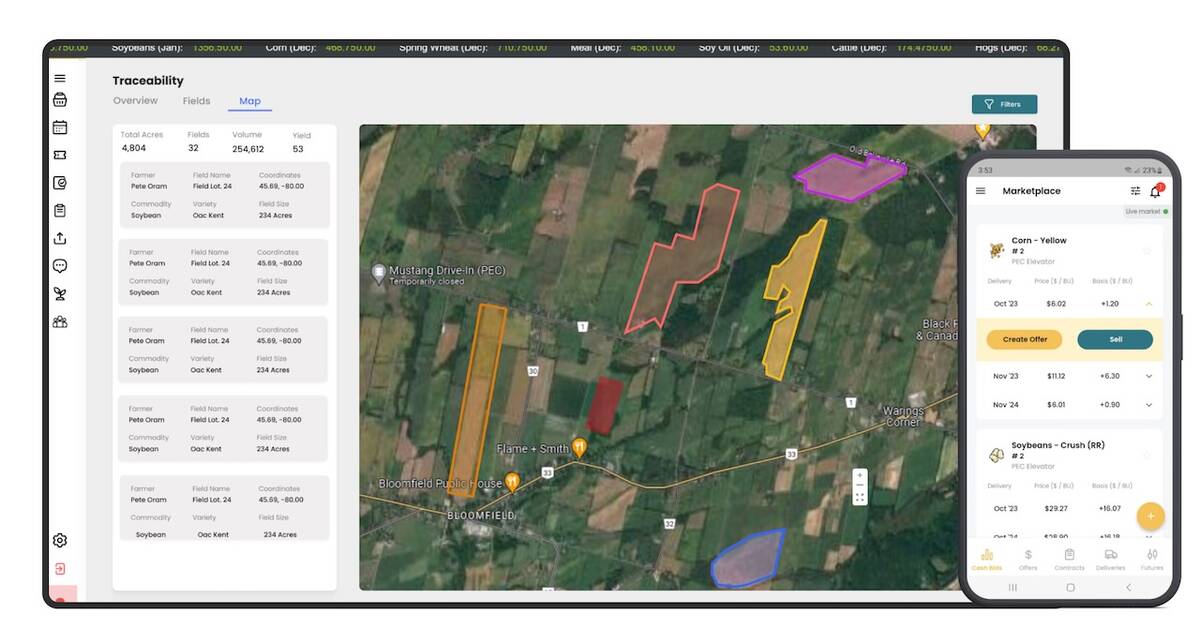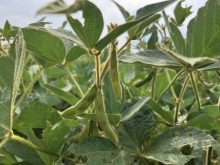Soybean production could play a significant role in meeting not only economic, but also environmental sustainability goals.
Soybean researchers are already pivoting to try to meet the language set out by federal, provincial and territorial (FPT) Ministers of Agriculture last November, including greater focus on carbon impacts.
Why it matters: Industry stakeholders are looking to capitalize on the benefits of soybeans for meeting climate and production objectives set by the federal government.
Read Also

Ontario company Grain Discovery acquired by DTN
Grain Discovery, an Ontario comapny that creates software for the grain value chain, has been acquired by DTN.
The opportunity for soybeans to capture some of the $3 billion available in federal funding was discussed at the recent Northern Soybean Summit, hosted by Soy Canada last month. Research priorities moving forward and what barriers may exist for soybean production growth were discussed.
“New cluster research must directly tie into the government priorities to tell a story,” said Josh Cowan, vice-president of the Canadian Field Crop Research Alliance (CFCRA) and manager of research and innovation at the Grain Farmers of Ontario at the summit.
The soybean summit discussed how soybeans could meet the goals set out by FPT ministers in their ‘Guelph Statement’.
The statement highlighted priorities for next agricultural policy framework (APF), which will replace the current Canadian Agricultural Partnership (CAP) and set policy and funding directives from 2023 to 2028. Key priorities outlined in the statement are climate change and the environment, sustainable economic growth (including value-added opportunities), and sector resilience.
The CFCRA is a not-for-profit that brings together provincial farm organizations and industry partners to collaborate on research initiatives that are mutually beneficial to all parties. Its goal is to advance the genetic capacity of field crops in Canada, particularly soybean, corn, wheat, barley, and oat.
The organization has identified four strategic cluster goals that interface both its member goals, as well as those set out by Agriculture and Agri-food Canada (AAFC).
“That will allow us to directly address the AAFC priorities with tangible outcomes,” said Cowan.
The four goals are crop rotation diversity, value-added production, improved nutrient use efficiency, and reduced business risk.
The CFCRA will focus less on genetic improvement as an end-goal, during the 2023 to 2028 funding period, but “rather as a means to deliver specific traits that would perhaps make the crop more resilient to reduce business risk, or provide a new opportunity for value-added production” or even as a viable crop for farmers in shorter season regions, he said.
This includes looking at how soybeans can reduce nitrous oxide emissions, how they can adapt to climate change (both temperature and weather stresses), and how to protect the crop against insect, disease and weed losses, particularly when part of a crop rotation.
Evaluating protein differently
Adding value to soybeans will focus on protein content, which has been a limiting factor for the expansion of soybeans in shorter season areas, particularly in the Prairies. Cowan said opportunities exist for not only achieving the minimum protein standards in commodity soybeans, but for improving protein quality as well to increase competitiveness of high-value food grade soybeans.
“The potential benefits include diversification of domestic and international markets, as well as stability and growth of the Canadian processing industry resilience to trade disruptions,” he said, noting the stability of the high-value food grade soybean export market in 2020 despite major market disruptions.
In his laboratory at the University of Manitoba, animal nutrition professor James House is looking beyond the typical crude protein measurement used to calculate animal feed rations and focusing on the individual amino acids that make up the protein that are essential for animal growth.
His modeling and research shows that as crude protein is lowered, the proportion of key amino acids is higher – they are inversely related. “This is really important for livestock formulators. Focusing on crude protein alone does not account for the contribution of important amino acids for livestock feeding,” said House.
He said looking at the quality of the protein, rather than quantity, could help plant researchers understand the factors influencing protein content and choose or develop varieties best suited for shorter season areas.
Climate change: friend or foe?
Protein quality wouldn’t just benefit soybeans grown in the western region of Canada, it also has applications for areas in Eastern Canada that experience water and temperature stress during the crucial pod setting and filling stage.
The likelihood of these stresses occurring with greater frequency in the future is something Ontario soybean growers are likely going to experience in the next 30 years, said Ward Smith, an AAFC agroecosystem modelling scientist.
Smith is part of an AAFC-led research team tasked with modeling the impacts of climate change on major crops in Canada.
Taking an agroclimatic indices approach (see sidebar), the AAFC is using five global climate models over two periods of time (1985-2014 and 2015-2044) to determine how crop production has changed, and is likely to change in future due to climate change pressures, said Ward.
“Temperature in Canada is increasing quite drastically under climate change, increasing twice as fast as it is globally” he said. Canada had about a 1.4 to 1.8 degree increase in temperature across the country, when looking at a 30-year span with 2013 in the centre. “That is quite dramatic.”
For soybeans, Ward said by 2030 growers will be able to plant nearly one full week sooner than they did in 2013, and by 2050, this date stretches to two weeks for Ontario and Quebec, and between nine and 12 days earlier for Manitoba and Saskatchewan. This will allow for greater yields across the country, and will allow planting in cooler areas. Ward said the AAFC team is predicting a large increase in crop heat units as well, potentially increasing the majority group by one or even two in more northern areas.
Ward said the models agree that on average, precipitation up until 2030 will remain average, with a slightly less than average precipitation amount in August for Ontario.
“I think we’ll see increased production everywhere in Canada by 2030,” he said. “But beyond 2050, particularly in eastern Canada, there can get to be quite serious temperature stresses.”
Cassandra Tkachuk, research specialist with Manitoba Pulse and Soybean Growers, said one of the biggest challenges with climate change is the unpredictable weather that comes with it. Temperature and moisture extremes, depending on when they occur in the growth stage, can reduce protein levels and overall yield. Drought stress can also reduce nitrogen fixation capability of soybeans, “which is one of its shining qualities,” she said.
Excess moisture can delay seeding, and increase the potential of root rot, a growing problem in Canada. Smith said that increased future temperatures could increase the winter survival of fungal spores, and enhance growth of pathogens in the growing season. Also, intermittent disease threats will be influenced by extreme events such as severe flooding and thunderstorms, he said.
Despite the risk of adverse weather events from a warming climate, when used in rotation, soybeans have great potential for mitigating GHGs and capturing carbon in the soil.
Claudia Wagner-Riddle, an environmental scientist with the University of Guelph, said soybeans fit the ‘climate smart’ agriculture model favoured by the federal government, meeting the pillars of increased productivity, resilience to climate change, and mitigation of GHG emissions.
She said research comparing soil nitrous oxide (N20) emissions show that soybeans have significantly lower N20 emissions, and don’t emit CO2 from fertilizer compared to corn.
Net carbon change varies with soil type, management, and climate.
To really take advantage of the low carbon and soil health benefits of soybean in rotation, rotations should be more diversified, she said. The lowest soil carbon soil capture is under a corn-soy rotation, whereas the highest soil carbon is seen under continuous alfalfa. By adding winter wheat and a cover crop such as red clover into the corn-soy rotation, Wagner-Riddle and her research team hypothesize this will result in more carbon gain over time.
Her on-going research focuses on quantifying the carbon footprint of grains grown in Ontario, using farm-level data.
The research efforts of Wagner-Riddle, Smith, and House and many others were met with an enthusiastic response from summit attendees.
Cowan said the CFCRA will continue to look for market industry feedback to ensure the greatest value for the broader sector is met across Canada.
He said the CFCRA expects to be able to submit a full application packet to AAFC in the fall of 2022, and a successful research cluster to begin in April 2023.
“We’re really trying to get the linkage between value to the farmer and the environmental piece combined, so that there’s high likelihood of adaption of value to the sector when all is said and done.”
Agroclimatic indices
AAFC modelling is looking at how climate change affects temperature- and water-related factors that affect plant growth:
Temperature related
• Frost free period
• Planting date
• Crop heat units (CHU)
• Temperature Stress Index
• Number of hot days >30 C
• Number of days when the minimum temperature is between 10 and 25C
Water related
• Growing season precipitation
• Monthly precipitation
• Potential evapotranspiration minus precipitation (PE-P)
• Growing season max dry spell













